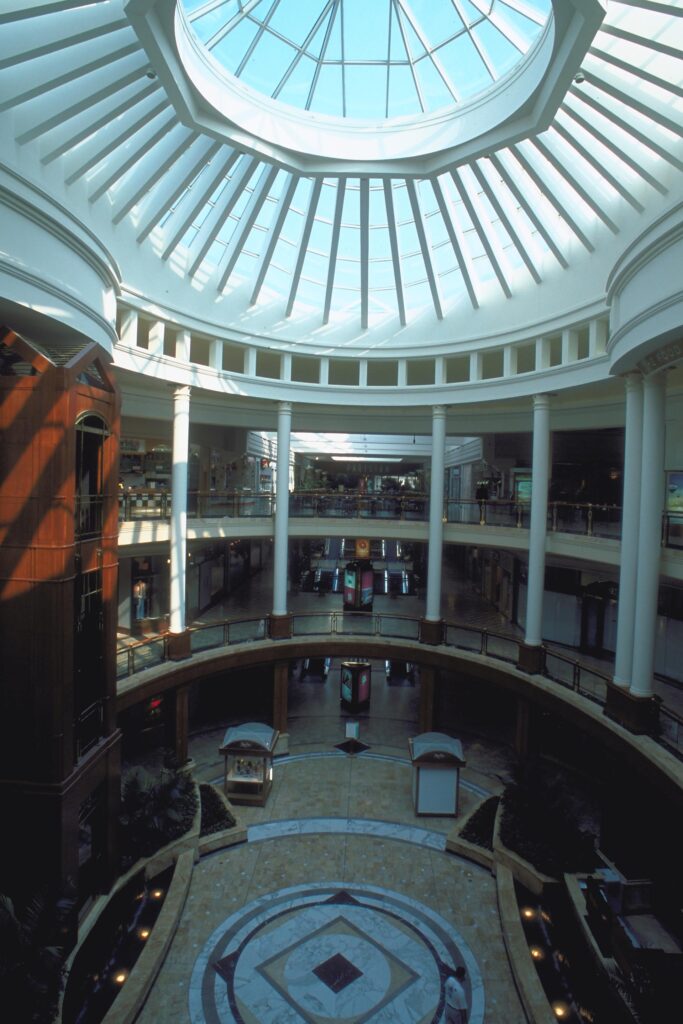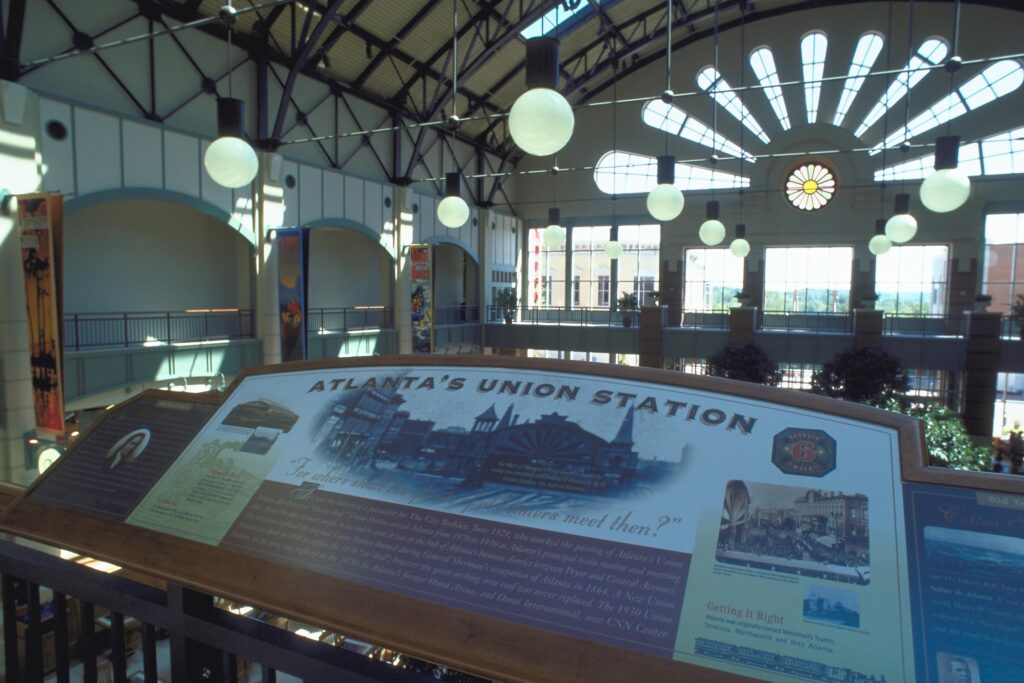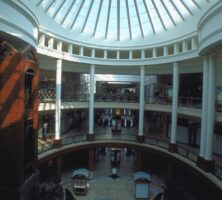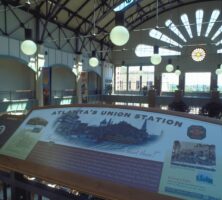Twentieth-century shopping center development in Georgia, as elsewhere, may be characterized as a revolutionary displacement of the marketplace from downtown business districts to the suburban edges of town and country and finally to regional malls.
In the late twentieth century, the village, with its perambulating buyers and sellers in marketplace stalls, gave way to urban sprawl, regional malls, and market megastructures dependent on automobiles, delivery trucks, high-speed connecting roads, acres of parking lots, and layered garages. In 1981 the Atlanta Journal-Constitution reported the existence of almost 900 shopping centers in the state, with more than one third of those in Atlanta. While the metropolis created cities within cities—such as John Portman’s insular Peachtree Center in Atlanta, with its wholesale markets and late-modern scale—the regional mall grew to the scale of a mini-city, demanding its own infrastructure, security police force, restaurants, and hotels.
Shopping Centers
Neighborhood markets and shopping centers continue to survive in towns across Georgia, as seen at Broad Street in Augusta, Little Five Points or the Virginia-Highland crossroads in Atlanta, and Broughton Street in Savannah, as well as around the perimeters of courthouse squares, such as those in Marietta or Newnan. Rhodes Center in Atlanta, built by Ivey and Crook in 1937 around Rhodes Hall (by W. F. Denny, 1903), represents an early phase of what scholars consider to be a modern “shopping center,” in that it was sited at the edge of town, along a commuter road to dormitory suburbs. In some ways Rhodes Center looked backward more than forward, as parked automobiles lined the street like horses at a hitching post.
In contrast, Georgia’s first true shopping center, Briarcliff Plaza (1939) on Ponce de Leon Avenue in Atlanta, was designed by George H. Bond with the automobile in mind and provided off-street parking. Anchoring the plaza and keeping it continuously active were, at one end, Plaza Drugs and, at the other end, the Majestic Restaurant. An art deco movie theater in the middle became the third pivot, with retail shops and cafes filling the remaining rental spaces.
Early post–World War II (1941-45) shopping centers in Georgia include Toco Hill Shopping Center (1959, restored by Rod Whatley in 1985-86) in Atlanta and North DeKalb Mall (1963-65) in Decatur. But preceding both was Georgia’s first regional mall, Lenox Square (1955-57), which was designed by Toombs, Amisano, and Wells. Stevens and Wilkinson built Rich’s Department Store there in 1957, and John Carl Warnecke of New York added Neiman Marcus Department Store in 1972.
Malls
Lenox Square, originally styled with mannered light concrete arches spanning an open-air street flanked by shops, was later enclosed and air-conditioned. The mall has been refaced many times since. The plaza court expansion of 1979-81 by Greenberg Farrow and Associates created a spatially lively, high-tech, enclosed piazza. MARTA arrived with its Lenox Square Station in 1984, and within two years the Lenox Square Mixed Use Development (Smallwood, Reynolds, Stewart, Stewart, and Associates) occupied a flanking site. Today Lenox Square’s 1950s and early 1960s character is no longer visible; indeed, commercial pressures encourage face-lifts for shopping centers more frequently than for other building types, to accommodate the changing tastes of consumers.
Prominent constructions of the mid-1960s in Atlanta were Ansley Mall (1967), which was built by Mastin Associates, and the Greenbriar Shopping Center (later Greenbriar Mall), which was designed by Edwards and Portman in 1965. Four years later, across from Lenox Square, the architectural firm FABRAP began early development on the upscale Phipps Plaza, which was expanded and renovated in 1991-92 by Thompson, Ventulett, Stainback, and Associates (TVS). The early 1970s witnessed the emergence of large suburban malls in Atlanta, notably Perimeter Mall (1971) by Katzmann and Associates, and Cumberland Mall (1973) and Southlake Mall (1974-76), both by TVS.

Courtesy of Georgia Department of Economic Development.
During the late 1960s and 1970s, Stevens and Wilkinson built Rich’s department stores throughout the region, notably at Perimeter Mall in Atlanta (1971), but also including “Rich’s II” at Peachtree Center (1973), where John Portman would later add a shopping gallery, and stores at Augusta Mall in Augusta (1978) and Cumberland Mall. Stevens and Wilkinson also designed Richway stores and built at least a dozen statewide, including the first constructed on Covington Highway in Decatur in 1968, and others in Marietta, Jonesboro, and College Park (all three 1969); Lilburn (1978); Austell (1979); and Athens (1979). The firm also constructed Richway stores outside Georgia, in Charlotte, North Carolina (1973-76); Columbia, South Carolina (1976); and two in Chattanooga, Tennessee, including one at Northgate Mall, in 1980.
Stevens and Wilkinson were similarly designing stores for Sears Roebuck during the same period throughout the Southeast. In Georgia, the firm built Sears department stores in Rome (1955), Marietta (1957), Decatur (1963), Atlanta (1964-66, in Buckhead), Columbus (1965), Savannah (1967), Tucker (1969), Augusta (1971), Morrow (1973, at Southlake Mall), Macon (1973), and Union City (1978, at Shannon Mall).
In Atlanta, planners for Perimeter Mall took special efforts to mix designers who might bring individual character to different sections of the mall: Stevens and Wilkinson at Rich’s (1971); Hellmuth, Obata, and Kassabaum (HOK, of St. Louis, Missouri) at Macy’s (1982); and Smallwood, Reynolds, Stewart, Stewart, and Associates at Rich’s Furniture Store (1986). This last firm had developed the Galleria specialty mall opposite Cumberland Mall in 1980-82.
TVS, however, offered the most noted specialists in mall design and remodeling. Along with designing Cumberland and Southlake malls, TVS also developed Gwinnett Place Mall in 1982-84 (Stevens and Wilkinson designed the Rich’s store there) and redesigned the 1965 North DeKalb Mall, renaming it Market Square, in 1985.

Courtesy of Georgia Department of Economic Development.
In 1997-99 TVS created Georgia’s largest shopping center, known as the Mall of Georgia at Mill Creek, which covers 1.7 million square feet on a 500-acre site at Buford, in Gwinnett County. With its Main Street and 80-acre nature center (complete with gristmill), the Mall of Georgia seeks to function like a village, thereby returning full circle to the historic downtown marketplace. The mall also features a 700-seat food court intended to recall Atlanta’s Union Station train depot.








